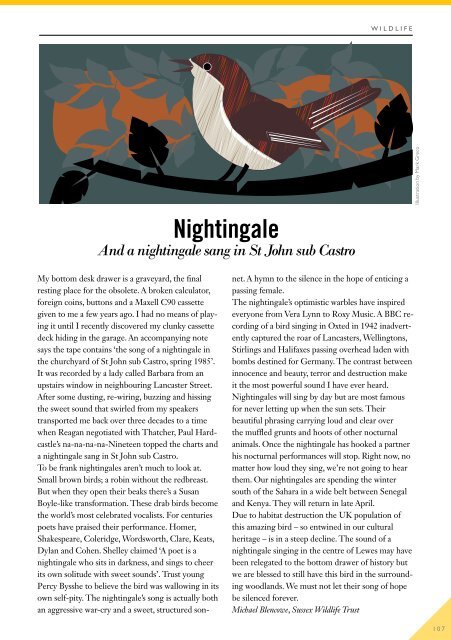Viva Lewes Issue #134 November 2017
You also want an ePaper? Increase the reach of your titles
YUMPU automatically turns print PDFs into web optimized ePapers that Google loves.
WILDLIFE<br />
Nightingale<br />
And a nightingale sang in St John sub Castro<br />
Illustration by Mark Greco<br />
My bottom desk drawer is a graveyard, the final<br />
resting place for the obsolete. A broken calculator,<br />
foreign coins, buttons and a Maxell C90 cassette<br />
given to me a few years ago. I had no means of playing<br />
it until I recently discovered my clunky cassette<br />
deck hiding in the garage. An accompanying note<br />
says the tape contains ‘the song of a nightingale in<br />
the churchyard of St John sub Castro, spring 1985’.<br />
It was recorded by a lady called Barbara from an<br />
upstairs window in neighbouring Lancaster Street.<br />
After some dusting, re-wiring, buzzing and hissing<br />
the sweet sound that swirled from my speakers<br />
transported me back over three decades to a time<br />
when Reagan negotiated with Thatcher, Paul Hardcastle’s<br />
na-na-na-na-Nineteen topped the charts and<br />
a nightingale sang in St John sub Castro.<br />
To be frank nightingales aren’t much to look at.<br />
Small brown birds; a robin without the redbreast.<br />
But when they open their beaks there’s a Susan<br />
Boyle-like transformation. These drab birds become<br />
the world’s most celebrated vocalists. For centuries<br />
poets have praised their performance. Homer,<br />
Shakespeare, Coleridge, Wordsworth, Clare, Keats,<br />
Dylan and Cohen. Shelley claimed ‘A poet is a<br />
nightingale who sits in darkness, and sings to cheer<br />
its own solitude with sweet sounds’. Trust young<br />
Percy Bysshe to believe the bird was wallowing in its<br />
own self-pity. The nightingale’s song is actually both<br />
an aggressive war-cry and a sweet, structured sonnet.<br />
A hymn to the silence in the hope of enticing a<br />
passing female.<br />
The nightingale’s optimistic warbles have inspired<br />
everyone from Vera Lynn to Roxy Music. A BBC recording<br />
of a bird singing in Oxted in 1942 inadvertently<br />
captured the roar of Lancasters, Wellingtons,<br />
Stirlings and Halifaxes passing overhead laden with<br />
bombs destined for Germany. The contrast between<br />
innocence and beauty, terror and destruction make<br />
it the most powerful sound I have ever heard.<br />
Nightingales will sing by day but are most famous<br />
for never letting up when the sun sets. Their<br />
beautiful phrasing carrying loud and clear over<br />
the muffled grunts and hoots of other nocturnal<br />
animals. Once the nightingale has hooked a partner<br />
his nocturnal performances will stop. Right now, no<br />
matter how loud they sing, we’re not going to hear<br />
them. Our nightingales are spending the winter<br />
south of the Sahara in a wide belt between Senegal<br />
and Kenya. They will return in late April.<br />
Due to habitat destruction the UK population of<br />
this amazing bird – so entwined in our cultural<br />
heritage – is in a steep decline. The sound of a<br />
nightingale singing in the centre of <strong>Lewes</strong> may have<br />
been relegated to the bottom drawer of history but<br />
we are blessed to still have this bird in the surrounding<br />
woodlands. We must not let their song of hope<br />
be silenced forever.<br />
Michael Blencowe, Sussex Wildlife Trust<br />
107


















